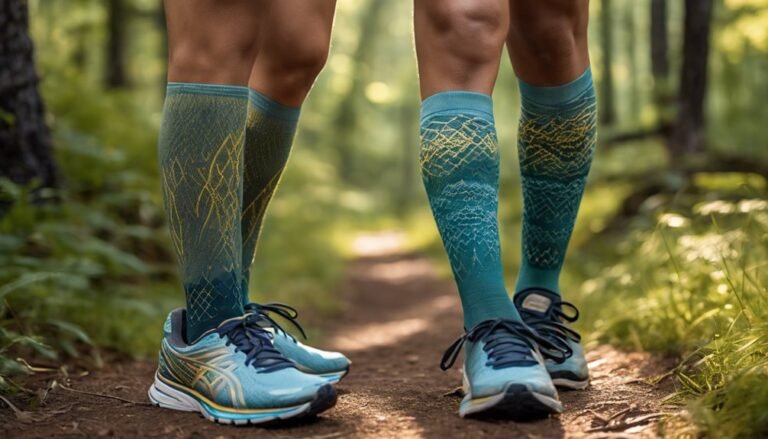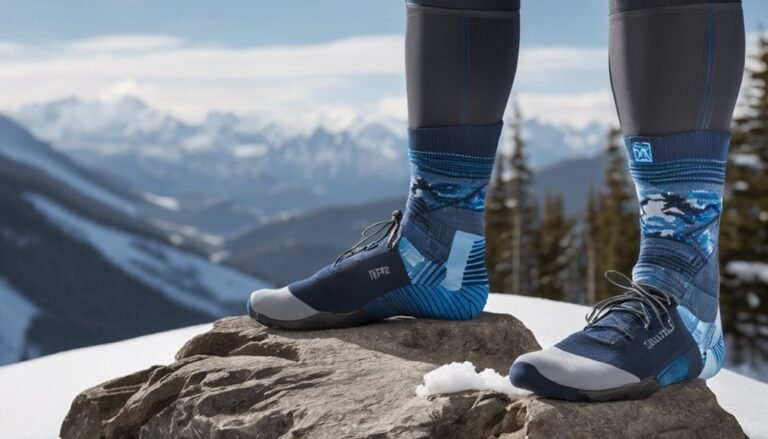How Firefighters Choose Heat-Resistant Socks
When choosing heat-resistant socks, you'll focus on essential features like high-temperature resistance, moisture-wicking properties, and durability. Look for materials like aramid fibers and wool blends, which offer comfort and protection. Consider insulation levels that balance warmth without causing overheating. A proper fit and reinforced design enhance performance during operations. Maintenance is vital for longevity, so follow care instructions closely. Discover how these factors contribute to your safety and efficiency on the front lines.
Importance of Heat-Resistant Socks for Firefighters

When battling blazes, the right gear can be the difference between safety and injury, and heat-resistant socks are a crucial component of a firefighter's uniform. These socks undergo rigorous performance testing to guarantee they meet essential safety standards. Their ability to withstand high temperatures protects your feet from burns and blisters, which can occur during intense firefighting situations. Additionally, heat-resistant socks help manage moisture, reducing the risk of fungal infections that can arise from prolonged exposure to wet conditions. When you prioritize the right materials and adhere to established safety protocols, you're not just enhancing your comfort; you're actively safeguarding your health and increasing your operational efficiency. Investing in high-quality heat-resistant socks is a significant step in securing your safety on the front lines.
Key Materials Used in Firefighter Socks
When choosing firefighter socks, you'll want to focus on the key materials that guarantee heat resistance, moisture-wicking, and durability. High-performance fibers, like aramid and wool blends, provide essential heat protection while maintaining comfort. Additionally, selecting materials engineered for longevity will help withstand the rigorous conditions firefighters face.
Fibers for Heat Resistance
Selecting the right fibers for heat-resistant socks is essential for firefighters' safety and performance. Aramid fibers, known for their high temperature resistance, are a top choice in the construction of these socks. They withstand extreme heat, providing a protective barrier against flames and hot surfaces. These synthetic fibers offer not just durability but also excellent strength-to-weight ratios, guaranteeing that your socks are lightweight yet robust. Additionally, aramid fibers resist melting and combustion, making them ideal for high-risk environments. When you choose socks made with these advanced materials, you're investing in your protection and comfort during critical operations. Prioritizing quality fibers like aramid guarantees that you can focus on your mission without compromising safety.
Moisture-Wicking Properties
In addition to heat resistance, moisture-wicking properties are essential for firefighter socks to guarantee comfort during intense operations. These features enhance performance by keeping your feet dry, which is critical for thermal regulation in high-stress environments. When selecting moisture-wicking socks, consider the following materials:
- Merino Wool: Naturally moisture-wicking and breathable.
- Nylon: Offers durability while effectively managing sweat.
- Polyester: Promotes rapid drying and excellent moisture management.
- Bamboo: Provides a soft feel and antimicrobial properties.
Choosing the right combination of these materials can greatly contribute to your overall comfort and performance enhancement, helping you stay focused and effective in your essential role.
Durability and Longevity
Durability is vital for firefighter socks, as they must withstand the rigors of intense environments and frequent use. Key materials like aramid fibers and reinforced blends are commonly used in sock construction to enhance strength and heat resistance. These high-performance materials undergo rigorous performance testing to guarantee they meet industry standards. You'll find that socks designed for firefighters often feature reinforced toe and heel areas, which improve longevity and reduce wear during demanding activities. Additionally, the knitting technique plays a vital role in enhancing durability by creating a dense, resilient structure that can endure harsh conditions. By choosing socks with these characteristics, you're assuring both durability and comfort, vital for those critical moments on the job.
Insulation Levels: Finding the Right Balance
While you might prioritize heat resistance in your choice of socks, finding the right insulation level is equally essential for maintaining comfort during firefighting duties. The right balance guarantees thermal regulation and helps you stay focused on your tasks.
Consider these insulation types when selecting your socks:
- Lightweight Insulation: Ideal for warmer conditions, providing minimal warmth while allowing breathability.
- Medium Insulation: Offers a balance, suitable for varied environments, guaranteeing comfort without overheating.
- Heavy Insulation: Best for extreme cold but may lead to overheating in active scenarios.
- Layered Insulation: Combines multiple insulation types for adaptability based on changing conditions.
Moisture-Wicking Properties for Comfort

Choosing socks with effective moisture-wicking properties is essential for maintaining comfort during firefighting operations, as excess moisture can lead to blisters and discomfort. Look for socks made from breathable fabrics that effectively draw moisture away from your skin, ensuring your feet stay dry. This is vital when you're in high-stress situations where sweat can accumulate quickly. Additionally, consider sock layering; a moisture-wicking inner layer can enhance comfort by managing sweat while an outer heat-resistant layer provides protection. By combining these features, you can markedly reduce the risk of foot fatigue and irritation. Ultimately, selecting the right moisture-wicking socks allows you to focus on your duties without the distraction of uncomfortable, damp feet.
Fit and Design Considerations
When selecting heat-resistant socks for firefighters, proper fit and design are essential for ideal performance and safety. You can't overlook sock sizing and ergonomic design, as they directly impact comfort and mobility. Here are key considerations to keep in mind:
- Accurate Sizing: Confirm you choose the right sock size to prevent bunching or slipping.
- Arch Support: Look for socks with built-in arch support to reduce fatigue during long shifts.
- Padding Distribution: Select designs that offer targeted cushioning for high-impact areas, like heels and toes.
- Seam Construction: Opt for flat seams to minimize friction and blisters, enhancing overall comfort.
Maintenance and Care for Longevity
To guarantee the longevity of heat-resistant socks for firefighters, proper maintenance and care are essential. Start with sock washing; always follow the manufacturer's instructions. Use mild detergents and avoid bleach or fabric softeners, as these can degrade the materials. Washing in cold water is preferable to maintain the fibers' integrity.
After washing, air dry your socks instead of using a dryer to prevent shrinkage.
For storage tips, keep socks in a cool, dry place away from direct sunlight. Avoid folding them tightly, as this can cause creases that weaken the fabric over time. By following these guidelines, you'll ascertain your heat-resistant socks remain effective and extend their lifespan, allowing you to focus on what matters most: your safety.
Frequently Asked Questions
How Often Should Firefighters Replace Their Heat-Resistant Socks?
You should assess sock durability regularly, replacing them every three to six months or sooner if you notice wear. This replacement frequency helps maintain ideal protection and comfort during demanding firefighting conditions, ensuring your safety.
Can I Use Regular Socks as a Substitute in Emergencies?
Using regular socks in emergencies is like using a paper shield in battle; it won't protect you. Emergency preparedness demands specialized sock materials designed for heat resistance, ensuring safety and functionality when every second counts.
What Brands Are Most Recommended for Firefighter Socks?
When considering recommended brands for firefighter socks, focus on material durability and heat resistance. Brands like Fox River and Thorlo offer exceptional performance. Research brand comparisons to guarantee ideal protection and comfort during your duties.
Are There Specific Socks for Different Firefighting Environments?
Yes, there are specific socks designed for various firefighter environments. Different sock materials, like wool or synthetic blends, provide varying levels of insulation and moisture management, ensuring comfort and performance in extreme conditions you might face.
How Do I Properly Clean My Firefighter Socks?
You won't believe how essential sock maintenance is! Use gentle washing techniques, like cold water and mild detergent, to keep your firefighter socks in top shape. Avoid fabric softeners; they can compromise heat resistance.







